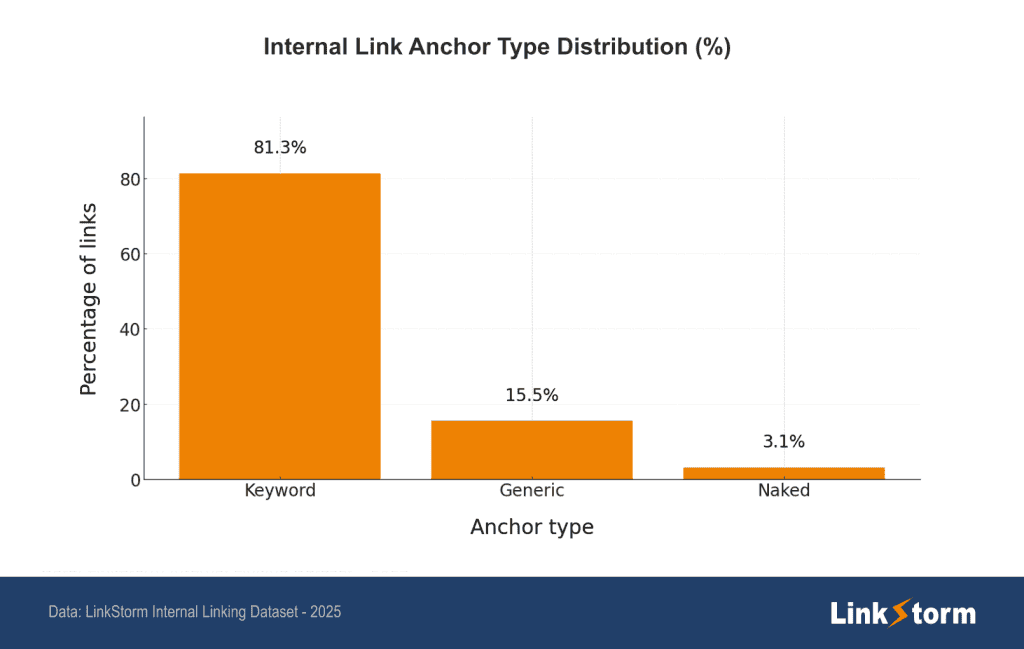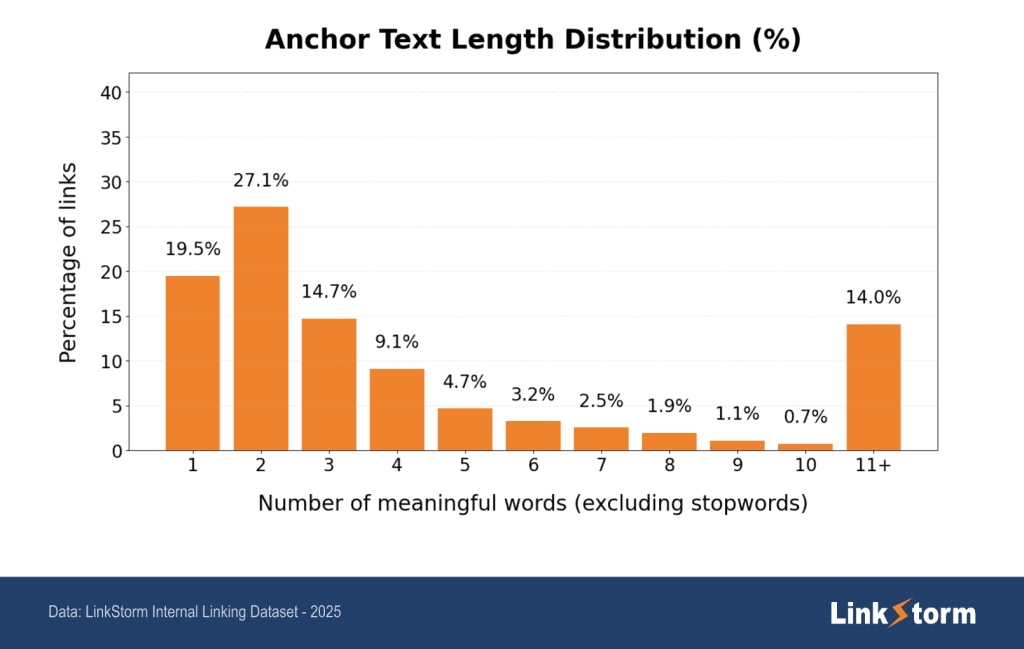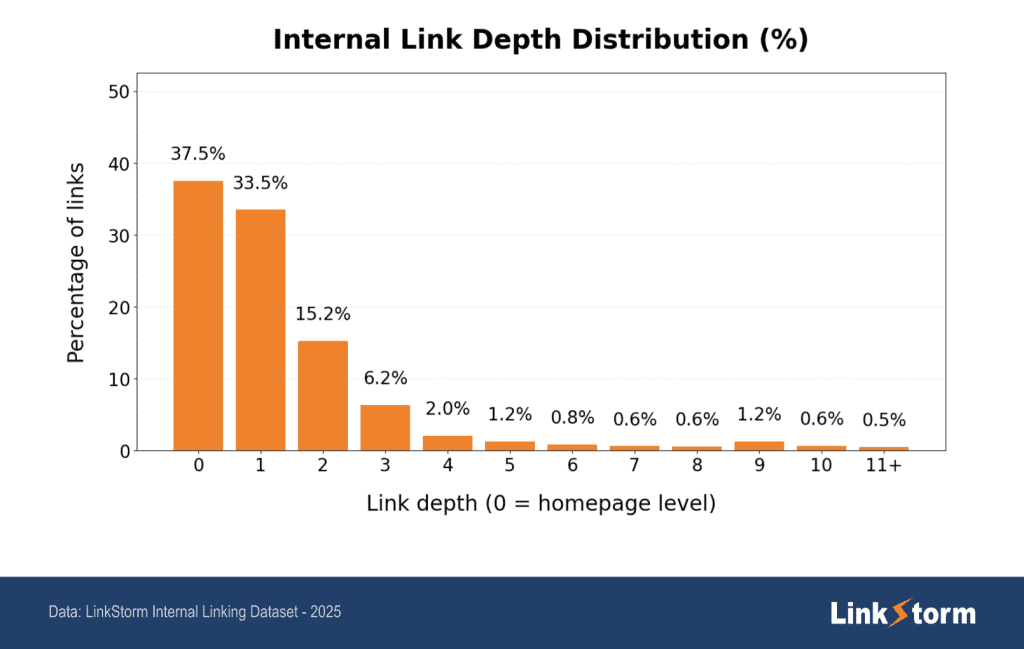2.5 Million Internal Links study: How Websites Link Their Content
Internal linking is one of SEO’s most influential, but least measured ranking signals.
It shapes how search engines understand your site’s hierarchy, how link equity flows, and how users (and crawlers) discover new pages.
Yet most SEO discussions about internal linking are based on theory, not large-scale data.
At LinkStorm, we process customer websites to identify internal link opportunities.
This gives us a unique, high-quality dataset: 2.5 million contextual internal links drawn directly from the main content across 1,700 real websites.
This study explores how websites actually link their content, what kinds of anchors they use, how long those anchors are, how closely they match the target page’s topic, and how deep those links go in the site structure.
All figures below are based on contextual links only, representing the parts of internal linking that truly matter for topical relevance.
What Google Says About Internal Linking
Before diving into the data, it’s worth hearing directly from Google.
In this short video from Google Search Central, the team explains how internal links help Google understand your content’s structure and determine which pages are most important. They stress that:
- Internal links guide both users and crawlers through your site.
- Anchor text should clearly describe the linked page’s topic.
- Using relevant, descriptive links within your content helps Google discover and contextualize your pages more effectively.
Watch Google’s official overview of internal linking best practices (Google Search Central).
Together, these recommendations form the foundation of sound internal linking strategy. In the following chapter, we’ll see how closely websites actually follow these best practices
About the Dataset
- Source: anonymized customer websites processed by LinkStorm’s internal linking engine.
- Scope: 2.5 million contextual internal links across 1,700 sites.
- Filtering: only links where both the anchor and target title were non-empty after cleaning.
- Focus: main content links (menus, sidebars, navigation, footers, and boilerplate removed).
This dataset provides one of the most representative looks at internal linking in natural content.
Anchor Type Distribution

Findings
- ~81 % of anchors are keyword-rich
- ~15 % are generic (“read more”, “click here”)
- ~3 % are naked URLs
Insight
Most internal links use what Google recommends: descriptive, keyword-based anchors.
“Good anchor text is descriptive, reasonably concise, and relevant to the page that it’s on and to the page it links to.”
— Google Search Central
However, around 15 % of anchors are still generic. Combined with later findings on low anchor-target similarity (see below), this suggests that while internal linking practices are generally solid, there’s room to improve contextual precision.
SEO takeaway
Most SEOs follow best practices by using descriptive anchors, but many internal links still rely on vague text like “read more” or “click here.” Replacing these with meaningful phrases tied to the target’s topic improves both topical relevance and internal equity flow.
As Google notes, descriptive anchor text helps “people and Google understand the page you’re linking to.”
Anchor Text Length Distribution

Findings
- Around 61% of anchors contain 1–3 meaningful words.
- A surprisingly large 14% of anchors are very long (11+ words).
- Mid-length anchors (5–10 words) are relatively rare in total.
Insight
Internal anchors strongly cluster at the extremes:
- Very short anchors (1–3 words) that highlight a core keyword or phrase.
- Very long anchors (11+ words) that often look like full clauses or sentence fragments taken from the surrounding text.
Short anchors are great for clarity and topic focus. That’s why 1–3 word anchors dominate.
But the presence of many very long anchors shows another pattern: some content uses very long phrases. Those are valuable when they genuinely describe the destination page.
SEO takeaway
Anchors in the 3–8 word range are an interesting sweet spot: long enough to carry nuance, short enough to stay focused. They’re underused, which suggests an opportunity to improve how internal links communicate meaning, both to search engines and to language models.
Anchor–Target Title Similarity

Findings
- 28 % of anchors have no similarity to their target title
- 63 % show low-to-moderate similarity (< 0.4)
- Only 8 % are strongly aligned (> 0.7)
Insight
Contextual internal links often connect pages that aren’t semantically aligned.
Many anchors appear to serve navigational or UX purposes rather than reinforcing topical relevance.
SEO takeaway
Improving topical alignment between the anchor and the target page enhances internal relevance signals and strengthens the site’s topical authority.
Google’s guidance is clear:
“Anchor text… tells people and Google something about the page you’re linking to.”
— Google Search Central
Methodology note
For this analysis, similarity was computed using a Jaccard-style word-overlap metric between anchor text and target title.
This approach prioritizes scalability and performance across millions of links.
While it doesn’t capture deep semantic meaning (as embeddings would), it provides a consistent and interpretable measure of topical overlap suitable for large-scale benchmarking.
Internal Link Depth Distribution

Findings
- 71 % of contextual links appear within the first two levels of the site hierarchy.
- Less than 6 % reach depth ≥ 4.
Insight
The data suggests that most websites maintain a flat internal structure: important pages are reachable within a few clicks.
SEO takeaway
A shallow structure is generally positive for crawl efficiency and link equity flow.
But including a few deeper links can provide extra context for understanding hierarchical relationships and topic clusters.
What the Patterns Show
Across 2.5 million contextual internal links, a clear picture emerges:
- Internal anchors are largely keyword-rich and short, with most containing only 1–3 meaningful words.
- Site structures are shallow, which supports efficient crawling and link equity flow.
- Semantic alignment between anchors and their target pages is low, with nearly half of anchors showing minimal meaningful overlap.
This means most SEOs excel at clarity and crawlability, but there’s room to improve semantic richness and creating links that connect meaning as well as structure.
For SEOs, this translates to opportunity:
Improve internal linking not only to distribute PageRank but to build a meaningful topical network that reflects how your content relates.
About LinkStorm
LinkStorm is an AI tool that builds smarter internal links for your site.
It scans your content, detects missed opportunities, and recommends context-rich anchors that make sense semantically. It can inject the links directly into your content and works for any CMS and platforms.
Cite This Study
If you reference these findings in an article, presentation, or dataset, please cite:
LinkStorm Internal Linking Study (2025 edition):
2.5 million contextual internal links analyzed across 1,700 websites.
https://linkstorm.io/resources/internal-link-study
Get a complete picture of your internal linking.
Build relevant links. Fix internal link issues.
Try it with your website!